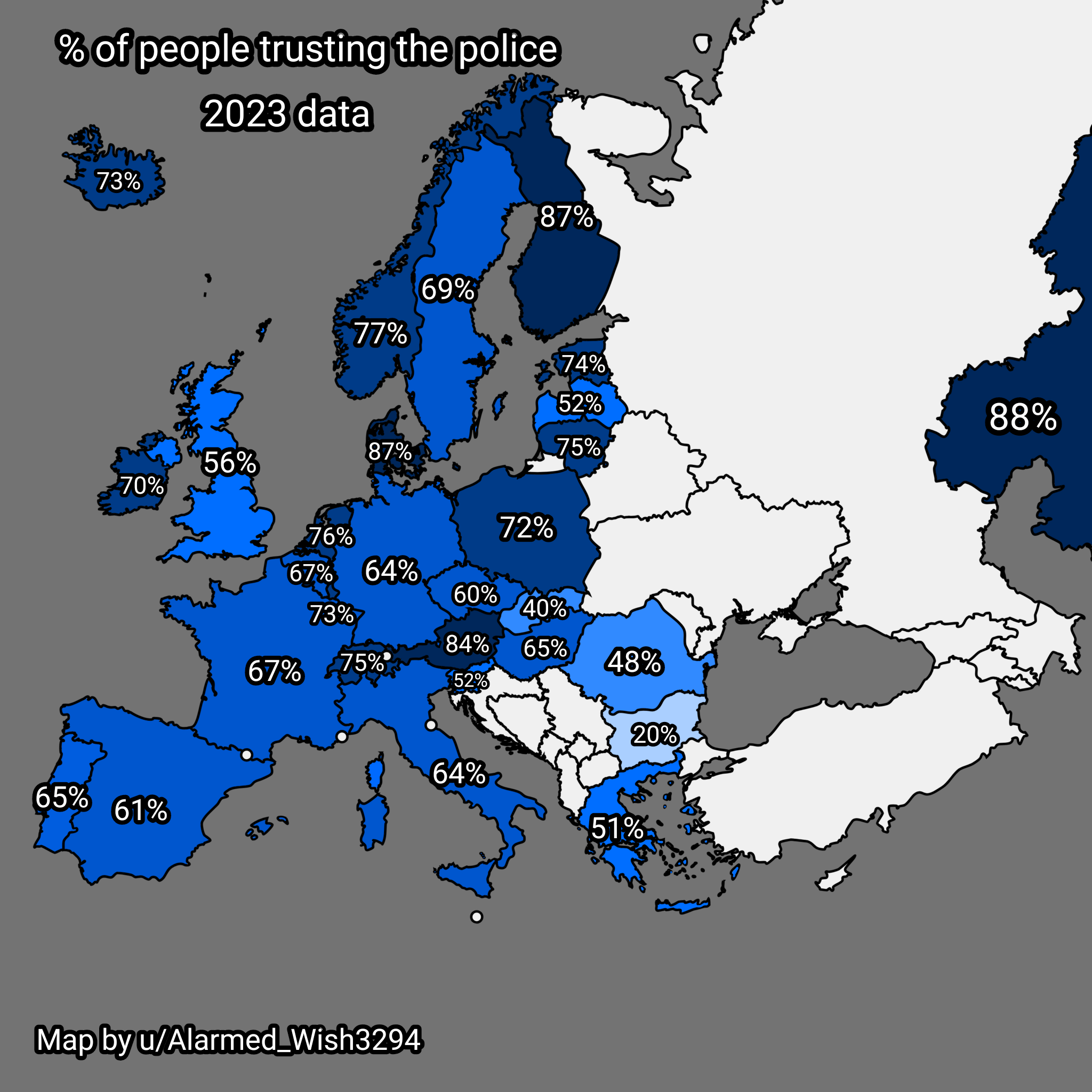Map of Trust in Police Across Europe


Alex Cartwright
Senior Cartographer & GIS Specialist
Alex Cartwright is a renowned cartographer and geographic information systems specialist with over 15 years of experience in spatial analysis and data...
Geographic Analysis
What This Map Shows
This map illustrates the percentage of people in various European countries who express trust in their police forces. Trust in law enforcement is a critical indicator of a society's overall confidence in governmental institutions and the rule of law. With varying levels of trust across the continent, this visualization highlights both the differences and similarities in perceptions of police across Europe.
Deep Dive into Trust in Police
Trust in police is more than just a statistic; it reflects the relationship between citizens and their law enforcement agencies. Factors influencing this trust include historical context, socio-economic conditions, crime rates, and public perception of the police's effectiveness and integrity.
Interestingly, countries with a high level of trust in police often have lower crime rates and more effective law enforcement. For instance, Nordic countries such as Finland and Sweden consistently report high trust levels—often above 80%. This can be attributed to their long-standing traditions of transparency, community policing, and strong social welfare systems that contribute to overall societal stability.
On the other hand, countries with lower trust levels, such as Romania and Bulgaria, often face challenges related to corruption and inefficiencies in law enforcement. According to the OECD survey, only about 35% of Romanians reported trusting their police, which can be linked to historical issues related to governance and public safety. These sentiments can lead to a cycle of distrust, where citizens do not feel safe reporting crimes or cooperating with investigations, further complicating the police's ability to maintain order.
Public perception can also be significantly affected by recent events. For instance, protests and civil unrest can lead to spikes or drops in trust depending on how law enforcement responds. In the United Kingdom, events surrounding police conduct and accountability have influenced public perceptions, resulting in fluctuating trust levels. Trust is not static; it can evolve based on the current political climate, significant incidents of police misconduct, or successful community engagement efforts.
Additionally, the effectiveness of police in addressing contemporary issues such as cybercrime and terrorism also plays a role in public trust. Countries that adapt their policing strategies to tackle these modern challenges often see an increase in trust among their citizens.
Regional Analysis
When we break down the map by region, several trends emerge. Northern European countries tend to exhibit high trust levels, often exceeding 75%. For example, Finland leads with around 85% trust in its police, attributed to its effective community policing strategies and low crime rates. In contrast, Eastern European nations generally report lower trust levels. In Poland, for instance, trust is around 55%, while Bulgaria falls below 50%.
The Mediterranean region presents a mixed picture. Countries like Spain and Portugal display moderate trust levels, with around 60-70% of citizens expressing confidence in their police forces. This can reflect a more recent effort to modernize and build community relations following past authoritarian regimes. However, Greece has a trust level closer to 50%, highlighting ongoing issues related to economic instability and public dissatisfaction with government institutions.
Interestingly, countries like Switzerland and the Netherlands stand out with their unique approaches to policing and community engagement. Trust levels in these nations hover around 75-80%, bolstered by transparency and community involvement in policing strategies.
Significance and Impact
Understanding the levels of trust in police across Europe is crucial for informing policies that aim to strengthen democratic institutions and public safety. High levels of trust can lead to more effective policing, as communities are more likely to cooperate with law enforcement. Conversely, low trust can hinder police effectiveness and complicate efforts to ensure public safety.
As we look to the future, trends indicate that the perception of police will likely continue to evolve, shaped by ongoing social and political changes. With increasing scrutiny on police practices and calls for reform in many countries, the relationship between citizens and law enforcement agencies may undergo significant transformation. Enhancing transparency, accountability, and community engagement will be vital in building and maintaining trust in the police.
In conclusion, the percentage of people in Europe who trust their police reflects deeper societal values and historical contexts. It serves as a compass for understanding public sentiment toward law enforcement and highlights the ongoing challenges and opportunities for improving police-community relations in the region.
Visualization Details
- Published
- August 20, 2025
- Views
- 86
Comments
Loading comments...